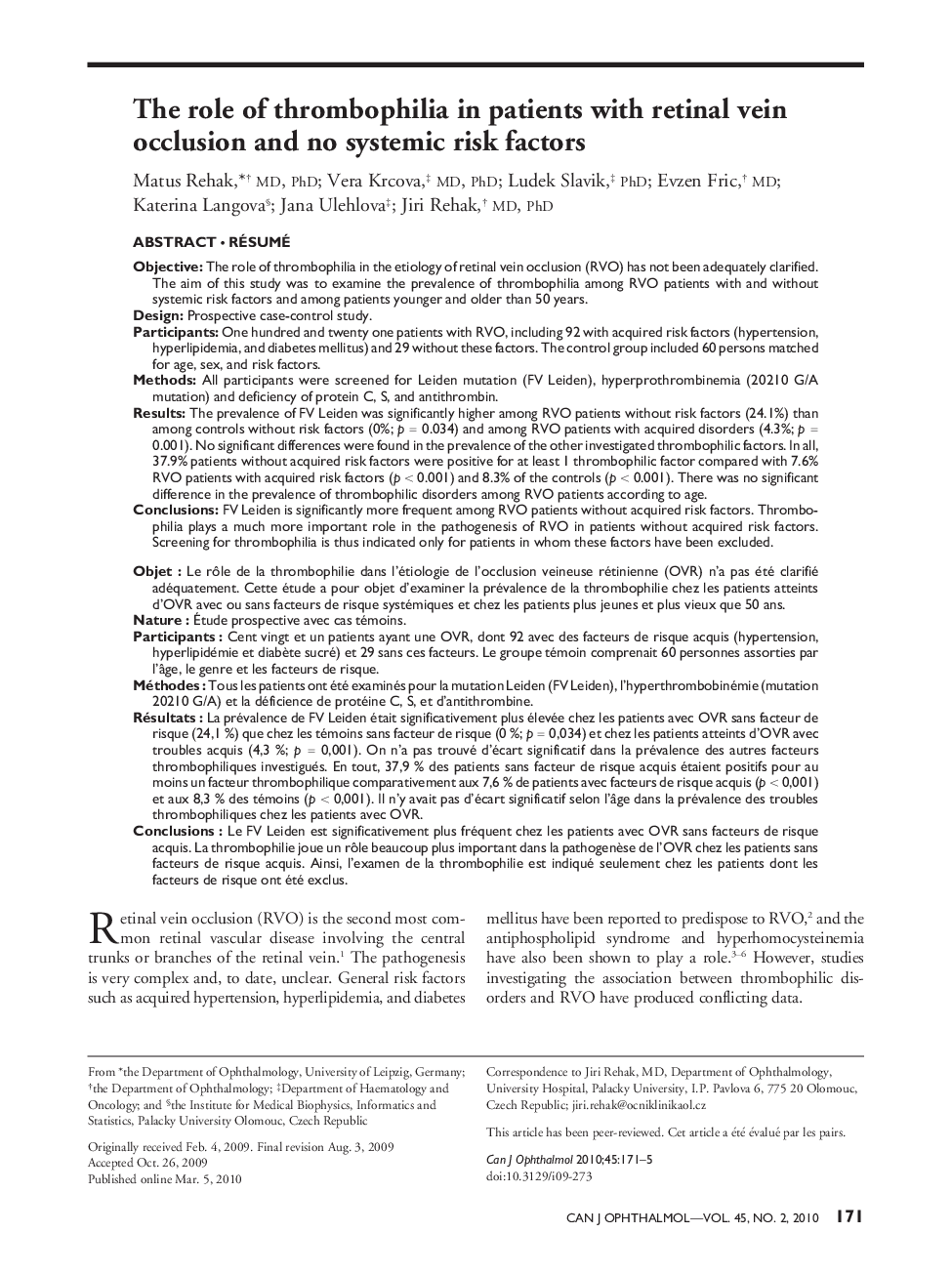| Article ID | Journal | Published Year | Pages | File Type |
|---|---|---|---|---|
| 4010365 | Canadian Journal of Ophthalmology / Journal Canadien d'Ophtalmologie | 2010 | 5 Pages |
Objective: The role of thrombophilia in the etiology of retinal vein occlusion (RVO) has not been adequately clarified. The aim of this study was to examine the prevalence of thrombophilia among RVO patients with and without systemic risk factors and among patients younger and older than 50 years.Design: Prospective case-control study.Participants: One hundred and twenty one patients with RVO, including 92 with acquired riskfactors (hypertension, hyperlipidemia, and diabetes mellitus) and 29 without these factors. The control group included 60 persons matched for age, sex, and risk factors.Methods: All participants were screened for Leiden mutation (FV Leiden), hyperprothrombinemia (20210 G/A mutation) and deficiency of protein C, S, and antithrombin.Results: The prevalence of FV Leiden was significantly higher among RVO patients without risk factors (24.1%) than among controls without riskfactors (0%; p = 0.034) and among RVO patients with acquired disorders (4.3%; p = 0.001). No significant differences were found in the prevalence of the other investigated thrombophilic factors. In all, 37.9% patients without acquired riskfactors were positive for at least 1 thrombophilic factor compared with 7.6% RVO patients with acquired riskfactors (p < 0.001) and 8.3% of the controls (p < 0.001). There was no significant difference in the prevalence of thrombophilic disorders among RVO patients according to age.Conclusions: FV Leiden is significantly more frequent among RVO patients without acquired risk factors. Thrombo-philia plays a much more important role in the pathogenesis of RVO in patients without acquired risk factors. Screening for thrombophilia is thus indicated only for patients in whom these factors have been excluded.
RésuméObjet: Le rôle de la thrombophilie dans l’etiologie de l’occlusion veineuse rétinienne (OVR) n’a pas été clarifié adéquatement. Cette étude a pour objet d’examiner la prévalence de la thrombophilie chez les patients atteints d’OVR avec ou sans facteurs de risque systémiques et chez les patients plus jeunes et plus vieux que 50 ans.Nature: Étude prospective avec cas temoins.Participants: Cent vingt et un patients ayant une OVR, dont 92 avec des facteurs de risque acquis (hypertension, hyperlipidémie et diabète sucré) et 29 sans ces facteurs. Le groupe témoin comprenait 60 personnes assorties par l’âge, le genre et les facteurs de risque.Méthodes: Tous les patients ont été examinés pour la mutation Leiden (FV Leiden), l’hyperthrombobinémie (mutation 20210 G/A) et la déficience de protéine C, S, et d’antithrombine.Résultats: La prévalence de FV Leiden était significativement plus élevée chez les patients avec OVR sans facteur de risque (24,1 %) que chez les temoins sans facteur de risque (0 %; p = 0,034) et chez les patients atteints d’OVR avec troubles acquis (4,3 %; p = 0,001). On n’a pas trouvé d’écart significatif dans la prévalence des autres facteurs thrombophiliques investigués. En tout, 37,9 % des patients sans facteur de risque acquis étaient positifs pour au moins un facteur thrombophilique comparativement aux 7,6 % de patients avec facteurs de risque acquis (p < 0,001) et aux 8,3 % des témoins (p < 0,001). Il n’y avait pas d’ecart significatif selon l’âge dans la prévalence des troubles thrombophiliques chez les patients avec OVR.Conclusions: Le FV Leiden est significativement plus fréquent chez les patients avec OVR sans facteurs de risque acquis. La thrombophilie joue un rôle beaucoup plus important dans la pathogenése de l’OVR chez les patients sans facteurs de risque acquis. Ainsi, l’examen de la thrombophilie est indiqué seulement chez les patients dont les facteurs de risque ont été exclus.
